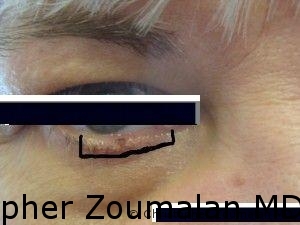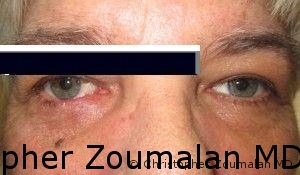Oculoplastic surgeons like myself routinely perform the removal of an eyelid skin cancer and then the reconstruction of the eyelid defect. The most common eyelid skin cancer is basal cell carcinoma but other kinds also include squamous cell carcinoma. The first part of the procedure involves removing the skin cancer and the second part involves eyelid reconstruction. There are two options for the removal of the skin cancer: the first is to remove it directly in the operating room and wait for the pathologist to make sure the margins are clear. This can often take a lot of time so I usually work with a Dermatologist who is trained in Mohs surgery. Fellowship-trainined Mohs surgeons are dermatologists who have received additional training in treating skin cancers. Once the Dermatologist sucessfully removes the eyelid skin cancer, I then see the patient (usually the same day or next day) to reconstruct the eyelid defect. There are various techniques that can be employed in the repair of an eyelid defect, and it depends on various factors such as the size of the defect and the laxity of the skin.
If it is a small defect, often local tissue can be rearranged or brought together to repair the eyelid. If it is a large defect like seen in the photo below, up to 80 percent of the lower lid is mssing along with the tear duct system. In such instances, tissue from the upper lid is often needed to repair the defect through a procedure called a Hughes flap (aka tarsoconjunctival flap) named after one of the pioneers in Oculoplastic Surgery, Dr. Wendell Hughes. Tissue is taken from the upper lid as seen in this following photo and transfered in the lower lid. Unfortunately, the eyelid is sewn shut for at least one month until the flap takes place. A second surgery is then performed to “take down” the flap and allow for the eyelid to be reconstructed to a normal-appearing eyelid.

This photo shows a squamous cell carcinoma of the right lower lid that after its complete excision, was left with a defect that spanned the markings drawn on the photo. The resection also involved her lower lid tear duct system. This particular patient did very well after the first stage and went home the same day with little discomfort.
The patient underwent a a second stage surgery which was performed several weeks later to detach the flap and reconstruct both upper and lower lids to position them as close to their natural, presurgcial position as possible. She is cancer free, can see from that eye now, and has a good position and contour of her lower lid. Note that she has lost her eyelashes in the lower lid which occured once the tumor was removed in the primary excision. [:es]
Oculoplastic surgeons like myself routinely perform the removal of an eyelid skin cancer and then the reconstruction of the eyelid defect. The most common eyelid skin cancer is basal cell carcinoma but other kinds also include squamous cell carcinoma. The first part of the procedure involves removing the skin cancer and the second part involves eyelid reconstruction. There are two options for the removal of the skin cancer: the first is to remove it directly in the operating room and wait for the pathologist to make sure the margins are clear. This can often take a lot of time so I usually work with a Dermatologist who is trained in Mohs surgery. Fellowship-trainined Mohs surgeons are dermatologists who have received additional training in treating skin cancers. Once the Dermatologist sucessfully removes the eyelid skin cancer, I then see the patient (usually the same day or next day) to reconstruct the eyelid defect. There are various techniques that can be employed in the repair of an eyelid defect, and it depends on various factors such as the size of the defect and the laxity of the skin.
If it is a small defect, often local tissue can be rearranged or brought together to repair the eyelid. If it is a large defect like seen in the photo below, up to 80 percent of the lower lid is mssing along with the tear duct system. In such instances, tissue from the upper lid is often needed to repair the defect through a procedure called a Hughes flap (aka tarsoconjunctival flap) named after one of the pioneers in Oculoplastic Surgery, Dr. Wendell Hughes. Tissue is taken from the upper lid as seen in this following photo and transfered in the lower lid. Unfortunately, the eyelid is sewn shut for at least one month until the flap takes place. A second surgery is then performed to “take down” the flap and allow for the eyelid to be reconstructed to a normal-appearing eyelid.

This photo shows a squamous cell carcinoma of the right lower lid that after its complete excision, was left with a defect that spanned the markings drawn on the photo. The resection also involved her lower lid tear duct system. This particular patient did very well after the first stage and went home the same day with little discomfort.
The patient underwent a a second stage surgery which was performed several weeks later to detach the flap and reconstruct both upper and lower lids to position them as close to their natural, presurgcial position as possible. She is cancer free, can see from that eye now, and has a good position and contour of her lower lid. Note that she has lost her eyelashes in the lower lid which occured once the tumor was removed in the primary excision.


